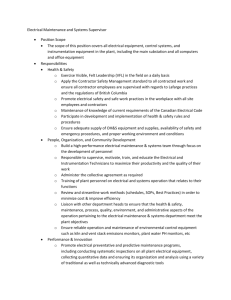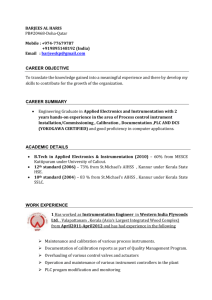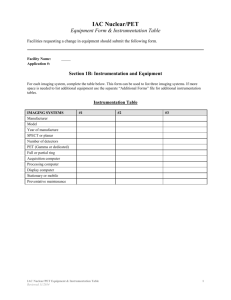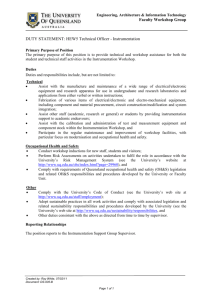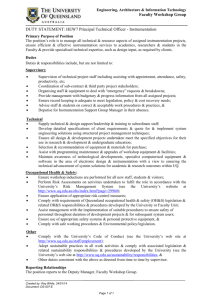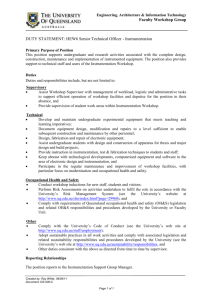CSD482 SYL WINTER 2014 - Western Washington University
advertisement
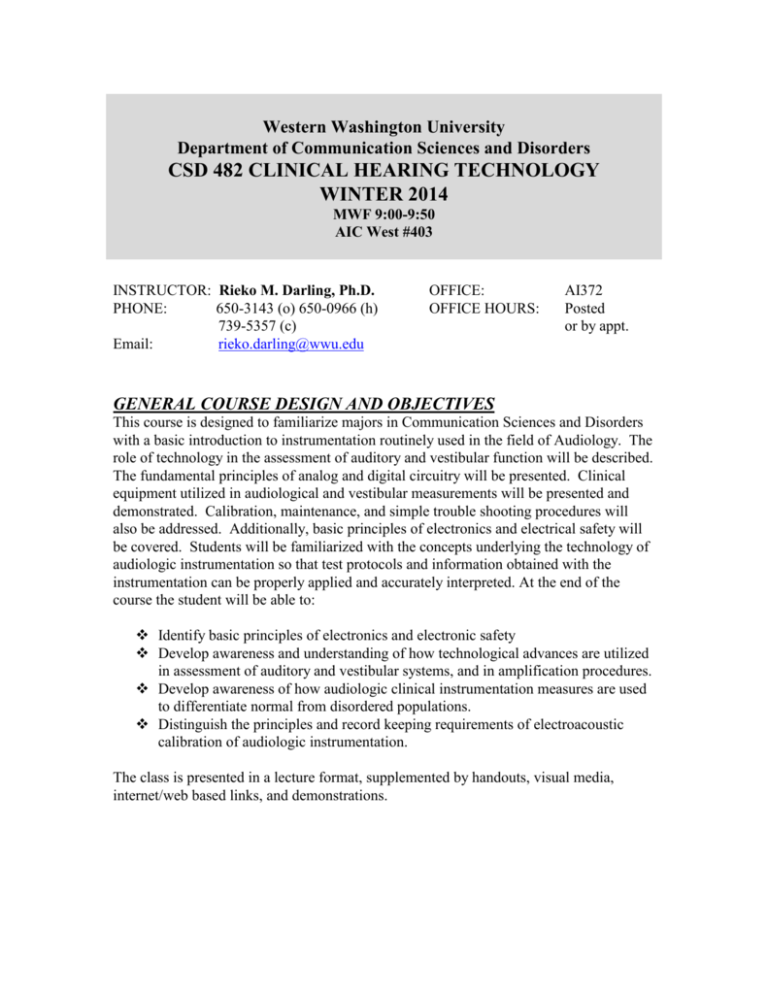
Western Washington University Department of Communication Sciences and Disorders CSD 482 CLINICAL HEARING TECHNOLOGY WINTER 2014 MWF 9:00-9:50 AIC West #403 INSTRUCTOR: Rieko M. Darling, Ph.D. PHONE: 650-3143 (o) 650-0966 (h) 739-5357 (c) Email: rieko.darling@wwu.edu OFFICE: OFFICE HOURS: AI372 Posted or by appt. GENERAL COURSE DESIGN AND OBJECTIVES This course is designed to familiarize majors in Communication Sciences and Disorders with a basic introduction to instrumentation routinely used in the field of Audiology. The role of technology in the assessment of auditory and vestibular function will be described. The fundamental principles of analog and digital circuitry will be presented. Clinical equipment utilized in audiological and vestibular measurements will be presented and demonstrated. Calibration, maintenance, and simple trouble shooting procedures will also be addressed. Additionally, basic principles of electronics and electrical safety will be covered. Students will be familiarized with the concepts underlying the technology of audiologic instrumentation so that test protocols and information obtained with the instrumentation can be properly applied and accurately interpreted. At the end of the course the student will be able to: Identify basic principles of electronics and electronic safety Develop awareness and understanding of how technological advances are utilized in assessment of auditory and vestibular systems, and in amplification procedures. Develop awareness of how audiologic clinical instrumentation measures are used to differentiate normal from disordered populations. Distinguish the principles and record keeping requirements of electroacoustic calibration of audiologic instrumentation. The class is presented in a lecture format, supplemented by handouts, visual media, internet/web based links, and demonstrations. Specific CSD 482 course learning outcomes and related ASHA certification standards: o Students will exhibit knowledge of basic anatomy and physiology of the perihperhal and central hearing, processing, and balance mechanisms. Standard IV-B: Biological, Neurological, Psychological, Developmental; Standard IV-C: Characteristics; Standard IV-D: Assessment o Students will describe the subjective attributes of sound. Standard IV-B: Acoustical; Psychological; Standard IV-D-Assessment, Treatment, Prevention o Students will understand what is meant by various type of decibels (sound pressure, hearing, sensation, etc.). Standard IV-B: Acoustical; Psychological; Standard IV-D-Assessment, Treatment, Prevention o Students will exhibit knowledge of basic audiologic protocols and equipment for assessment and treatment of hearing, processing, and balance issues Standard IV-D: Assessment, Treatment, Intervention REQUIRED READINGS Decker, T. and Carrell, T. Instrumentation (3rd Ed.), (2004) Lawrence Erlbaum Associates, Mahwah, NJ (copies of required sections provided for student to signout for short term review) Abbreviated versions of PowerPoint lectures on Blackboard Supplemental handouts posted on Blackboard or given in class ATTENDANCE You are expected to arrive on-time and be prepared for each class. This means that readings and assignments have been completed as appropriate. Attendance is required and class-attendance will be taken. I encourage you to obtain the lecture notes from your classmate(s) if you miss a class. You will be allowed (“forgiven”) one unexcused absence for the quarter. COURSE REQUIREMENT: Student performance will be evaluated via one inclass examination, a take home final examination, participation in class activities, and satisfactory completion of take-home assignments. Examinations (80%) will be based on information presented in class lectures, activities/assignments, readings, and handouts. The midterm exam (Exam #1) will be accomplished within a 50 minute class time frame. The final exam (Exam #2) will be a take home/open book/open notes type exam. All unexcused absences on the midterm exam date or failure to submit the take home final examination by the due date will result in a grade of F (0%) for that exam. There will be no "make-up" exams unless a medical excuse is presented or prior approval is obtained. Approved make-up time/date for a missed midterm class exam must be arranged with the instructor within 1 day following the original scheduled exam date. EXAM #1 (40%) – Date TBA TAKE HOME EXAM #2 (40%) - Due 3/21/14 by 12:30 pm Take Home Assignments and In-Class Activities (20%): Various “hands on” class activities will be accomplished throughout the quarter. Activities missed during these classes cannot be made up and will be weighed into the final grade. Out of class/take home assignments not submitted or presented by the due/assigned date will receive a grade of F (0%) for that assignment. There will be no extensions on take home assignments unless a medical excuse is presented or the instructor gives prior approval. GRADING SCALE: 92.5 to 100 pts= 89.5 to 92.49 = 86.5 to 89.49 = 82.5 to 86.49 = 79.5 to 82.49 = A AB+ B B- 76.5 to 79.49 72.5 to 76.49 69.5 to 72.49 66.5 to 69.49 62.5 to 66.49 = = = = = C+ C CD+ D 59.5 to 62.49 = 59.49 or less = DF NOTE: Students with specific disabilities requiring special accommodations must contact the Office of Disability Resources for Students (OM 110, ext. 3083) for verification, necessary forms, and coordination of services. ACADEMIC HONESTY Academic integrity is demanded throughout all aspects of coursework. Students are required to have read and to understand the Western Washington University Academic Dishonesty Policy and Procedure, as listed in the 2013-2014 Western Washington University Catalog (Appendix D). This policy states, in part: “All Western Washington University students have an obligation to fulfill the responsibilities of their particular roles as members of an academic community. Honesty is essential to learning. Without it, fair evaluation for all is impossible. Academic integrity is demanded, and academic dishonesty at Western Washington University is a serious infraction dealt with severely. No student shall not claim as their own, the achievements, work or arguments of others, nor shall they be a party to such claims”. For complete information and a list of examples illustrating academic dishonesty and plagiarism and procedures for academic dishonesty cases, refer to the 2013-2014 Catalog (Appendix D). TOPIC OUTLINE Basic Electronics, Power Supplies, and Electrical Safety o Electrical fields and charges o Current, voltage, resistance and power o Ohms law o Basic circuitry, open and short circuits o Grounding and other safety precautions Overview of Basic Instrumentation Components o Amplifiers, attenuators, mixers, switches, and filters o Input and output transducers o Analog-to-digital and digital-to-analog storage and converters o Wires, cables, connectors, and adapters Technology and Instrumentation for Assessment of Hearing and Auditory System Structures and Function o Otoscopy o Video otoscopy o Screening and diagnostic immittance units o Screening and diagnostic audiometers o Otoacoustic emission systems o Auditory evoked potential systems Technology and Instrumentation for Hearing Aid Analysis, Selection and Fitting Procedures o Electroacoustic analysis o Real ear probe microphone o Computerized fitting software and programming systems Technology and Instrumentation for Assessment of Dizziness and Vestibular System Structures and Function o Electronystagmography o Videonystagmography If time permits -- Calibration in Clinical Audiology o Calibration standards o Parameters of calibration o Equipment for performing electroacoustic calibration o Calibration of audiometric equipment o Audiometric test room standards and measurements o Biologic calibration and basic troubleshooting



